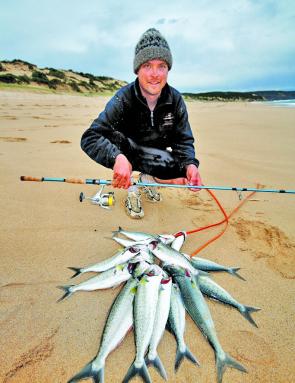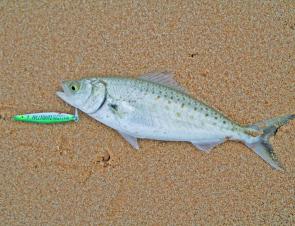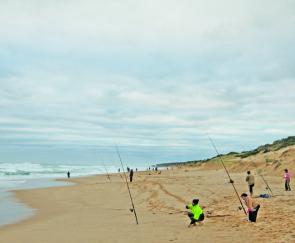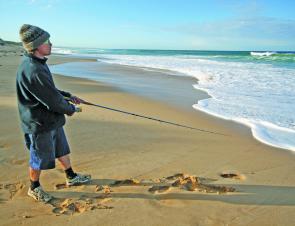We all love the winter surf fishing scene. For all of us maniac anglers out there, it gives us something to focus on through the cool winter months.
And while the cold winds and grey skies are tolerable, lugging truckloads of gear down the beach has never been something I have enjoyed. Resembling something closer to a pack horse can seriously take the fun out of the walk to your favourite surf hole a couple of kilometres down the beach. Well, there is a solution – surf spinning!
Very simply, surf spinning is the art of pegging lures, generally metal slugs, into the surf in the hope of catching some serious Australian salmon. That’s it in a nutshell, but in truth there is actually a lot to learn in order to increase your chance of hooking and landing fish.
But before we get into the technicalities I wanted to examine a couple of reasons why surf spinning has changed my whole outlook on winter beach fishing.
We all know that fish move around, they have tails and they swim. And sometimes when you’re having a slow day, it is not a case of there being no fish in the sea, it is just a case of there being no fish in the spot that you are fishing!
Herein lies the first and most important aspects of surf spinning – if the fish are not where you are fishing, go and find them! Most of the time you will have little more than a handful of slugs, maybe some leader material and your rod and reel.
This means that you can stay incredibly mobile, moving freely up and down the beach until you locate a school of feeding salmon. This is a wonderful part of spinning. No longer rooted to the beach by way of buckets, rod holders, multiple rods, backpack, esky and so on. You can go fossicking and find the fish!
The other wonderful element of spinning for salmon is that when you do find the fish, you can often catch many more than those fishing with baits.
Between yourself and a mate throwing lures into an excited pack of salmon will see you hook-up on most hits and instead of having to worry about re-baiting and re-setting your rods, you can simply remove the fish and have your lure back in the midst of the school in a matter of seconds.
I have had sessions where, between a couple of friends, we have pulled a couple of dozen fish in 15 minutes or so. This can be hot fishing!
There is plenty of good tackle on the market, and good tackle stores will have a range to look at and knowledgeable staff to advise you on what will suit best.
There are number of ideal surf spinning rods on the market these days, with the ideal set-up being a 9’ graphite spin rod. These rods vary in price but begin at around $120. They give you length for casting distance coupled with a nice crispness and responsiveness ideally suited to braid.
They are generally quite light with fairly fine blanks meaning you can cast all day without getting sore arms.
Shimano do a nice affordable model called the Catana 9’ Shorespin, check it out next time you’re hunting around your local tackle store.
As far as reels go, high-speed retrieve ratios are good but not strictly necessary. For ease of use, I would recommend a threadline reel, but there are no real demands on make or model aside from getting a reel nicely matched to your rod that suits your budget.
Something in the 3-5000 size loaded with your choice of 20lb braid is ideal.
A word of warning – don’t go too light on your braid. Even though it will help you cast further, the force with which you cast metal lures will mean you lose a few to unwelcome break-offs when wind knots catch around your rod guides.
I top my braid with a couple of metres of 20lb fluorocarbon and then attach the smallest snap swivel I have, around a size 12, for easy lure changes.
Lures are the easy, and fun, part of your tackle selection with myriad variations on the market.
As mentioned earlier this is very much the realm of metal slugs, 35g and 50g being optimal size for maximizing your cast.
While soft plastics are an option, you will have to select your jig head carefully, as finding the right combination of weight and hook size is not easy in this derivation of lure fishing. Sometimes the jig head and hook will just be too big for the size lure you want to cast.
Lazer Lures, Spanyids, Surecatch Knights – there are a plethora of different slugs on the market that will suit the surf spinner’s needs. Try and always carry a range of colours, you never know which will work on the day.
Green and blue mackerel patterns, gold, red heads and pearl/silver are all popular choices – along with some of the new designs that include a bubble hole, which is basically an angled hole drilled through the lure that is designed to draw water and create a disturbance of bubbles as it is quickly retrieved.
We touched on technique early in the piece and in truth it is a pretty simple process. Keeping your retrieve rate up is important, even to the degree that the lure occasionally breaks the surface.
Adding a slight twitch to the rod can help, but speed is probably the most important element.
Like tuna, salmon are a species used to chasing down small baitfish and the frenetic speed and action of the lure is what will most likely entice the bite.
Like with bait fishing, targeting the holes and gutters of your local surf beach is key.
Make sure you cover each hole thoroughly, casting from a number of different points for the whole length of the deeper water. And if nothing presents itself, keep on moving.
Sometimes you will be surprised at how close to the shoreline the fish will hit, often sitting just behind the final shore break.
Don’t stop or break your retrieve until the lure is at your feet.
You will catch fish in all conditions, but in truth, the heaviest of surf days are probably best avoided.
Start off by picking a day with a wind coming over your shoulder, which will help your cast, and only a few foot of swell. It will make the day that much more enjoyable.
Finally, while many winter anglers out there are quite fond of their chest high waders, I would suggest that these are best left to hang in the laundry if you want to get serious about your beach spinning.
While the tingle of cool winter water on your toes may not appeal to all, keeping yourself able to move freely and walk considerable distances is one of the key elements of surf spinning.
And you never know; along with a couple of fish, a little bit of exercise might not be the worst thing for you either!
Reads: 28427
Joe Farr with a classic bag of winter salmon taken from Gunnamatta surf beach.

Salmon are voracious feeders – even small fish will attack relatively large slugs!

Leave the crowds! Surf spinning allows you to wander away and find your own patch of fish!

A cool winter’s day, perfect for beach spinning!

Joe Farr with a terrific bag of Australian salmon.




